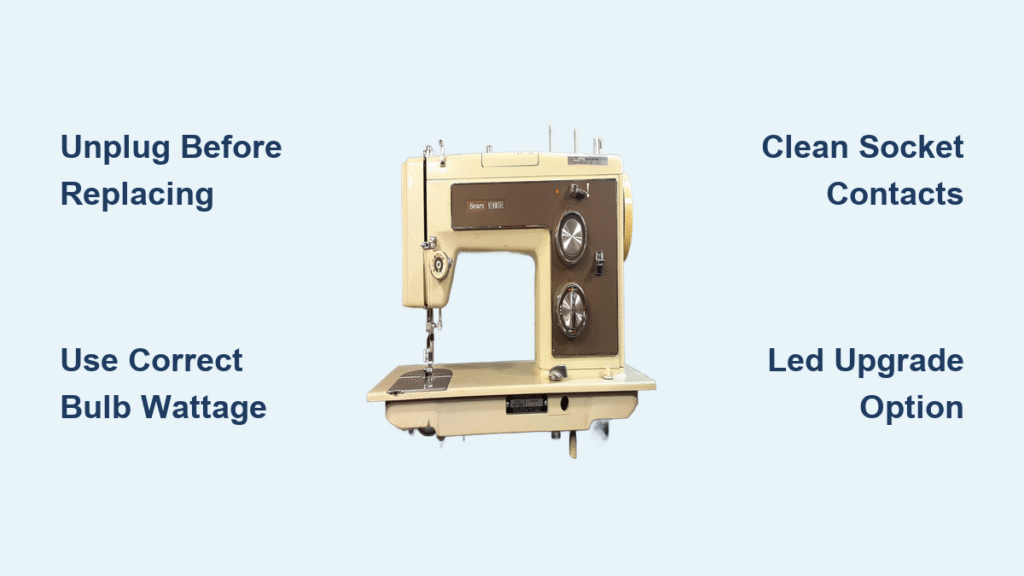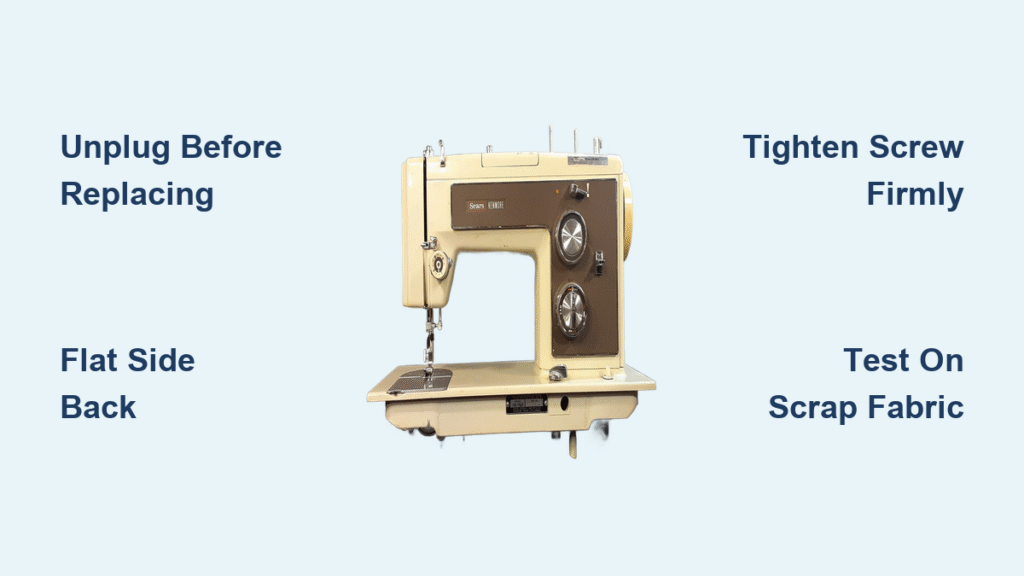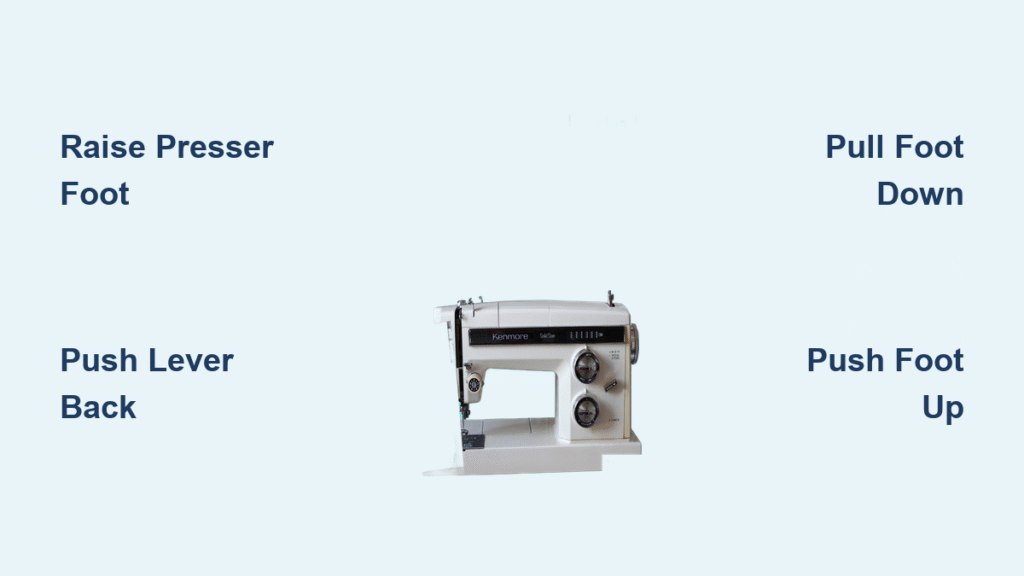Your Kenmore sewing machine’s light suddenly dying mid-project turns precise stitching into a guessing game. Whether you’re working on delicate embroidery or heavy denim, inadequate lighting causes missed stitches, needle breaks, and eye strain. This how to change light bulb on Kenmore sewing machine guide delivers model-specific solutions for both modern and vintage models—most replacements take under 10 minutes with no special tools. You’ll discover foolproof techniques to access stubborn sockets, avoid common mistakes that damage sockets, and decide whether LED upgrades are worth the investment.
Don’t let a burnt-out bulb derail your creative flow. With the right approach, you’ll restore professional-grade illumination to your workspace and prevent future failures. This guide covers every critical detail—from safely removing broken glass shards to selecting bulbs that match your machine’s voltage requirements—so you can resume sewing with confidence.
Power Down and Safety Essentials
Unplug your Kenmore immediately before touching any components—these machines retain electrical charge even when switched off. Wait 10 minutes for hot bulbs to cool; incandescent units reach 200°F during operation. Handle replacements with cotton gloves or clean, dry hands to prevent skin oils from creating hot spots that shorten bulb life. Work over a towel to catch dropped parts, and ensure your workspace has strong ambient lighting to spot tiny socket components.
Critical safety check: Verify your machine is completely disconnected from power before accessing sockets. Never attempt bulb replacement while the machine is plugged in, even if the power switch is off. For vintage models, inspect wiring insulation near the socket for cracks that could expose live wires during the process.
Kenmore 385 Series Bulb Replacement

Locate and Open the Light Housing
Your Kenmore 385 series (model 385.15516000) features a slide-access housing near the needle area. Push the plastic cover toward the machine’s rear until it clicks open—no tools required. The bayonet-style bulb sits directly behind this cover. If resistance occurs, check for lint buildup around the housing edges; use a soft brush to clear debris before forcing movement.
Remove the Push-In Bayonet Bulb
Position your fingers around the bulb base and push upward while twisting clockwise. Continue rotating until the button knob aligns with the leftmost slot in the socket. Pull straight out—if resistance persists, gently wiggle while maintaining upward pressure. Forcing rotation without upward movement risks breaking the bulb or damaging socket tabs.
Pro tip: If the bulb feels fused, wrap a rubber band around its base for extra grip. Never use pliers directly on the glass—they’ll shatter the bulb instantly.
Install the New Bayonet Bulb
Align the replacement bulb’s button pin with the socket slot (15W, 110-120V bayonet base). Push firmly upward while twisting counterclockwise until it locks on the right side—you’ll hear a distinct click. Test security with a gentle wiggle before closing the cover. Snap the housing shut until it clicks, plug in your machine, and verify full brightness before resuming sewing.
Warning: Using bulbs with incorrect wattage (like 25W) melts socket components. Always confirm 15W specifications.
Vintage 158 Series Light Access
Find the Hidden Bulb Location
Unlike modern models, Kenmore 158 series bulbs (models 158.901/158.902) hide under the machine arm—not in external housings. Turn your machine on its side with the head facing you to locate the access point. The bulb sits within the arm assembly, requiring disassembly for replacement. Use a flashlight to identify whether your model has a twist-off left side cover or requires under-arm access.
Three Access Methods
Method 1 (Twist Cover): Grasp the left side panel and rotate backward—it snaps off to reveal the bulb housing. Works reliably for 158.901/902 models but avoid excessive force on brittle vintage plastics.
Method 2 (Underneath Access): Reach through the neck assembly from below using needle-nose pliers. Requires excellent lighting and patience; best for users with small hands.
Method 3 (Full Side Access): Lay the machine completely on its side over a towel. This exposes the entire under-arm area but demands careful handling to prevent damage to delicate components.
Time estimate: 5-8 minutes for experienced users; up to 15 minutes for first-timers.
Handle Stuck or Broken Bulbs
For seized screw-in bulbs (Part #3815), wrap rubber bands around the base for grip before twisting counterclockwise. If the glass breaks, unplug immediately and use needle-nose pliers to grip the brass base edge—never insert tools into the glass shards. Rotate counterclockwise to remove remnants, then vacuum the socket before installing a new bulb. Clean contacts with a dry cloth to prevent future dimming.
Critical mistake to avoid: Forcing broken bulbs with pliers often strips the socket threads, requiring costly repairs.
LED Upgrade: Model 84 Conversion
Performance Benefits
Upgrading your Kenmore Model 84 to LED transforms dim yellow light into daylight-bright illumination. The Cree XR-E High CRI LED delivers 218 lumens with zero heat buildup—making needle threading effortless and revealing true thread colors. You’ll gain 50,000-hour lifespan (vs. 1,000 hours for incandescent) while using 75% less power. Projects no longer pause due to bulb failures or heat discomfort.
Required Components
Gather these before starting:
– Cree XR-E High CRI LED
– Two 1-ohm wire-wound resistors (10W each)
– Aluminum heatsink bracket
– Thermal compound and epoxy adhesive
– USB cable with 5V phone charger
– Plumber’s flux (for soldering oxidized wires)
Sourcing tip: Find resistors at Radio Shack or electronics stores; Sew-Classic sells blue-enhanced incandescent alternatives for vintage purists.
Installation Steps

- Disconnect power: Cut original lamp wires from the 110V connector—use plumber’s flux on oxidized copper.
- Mount LED: Secure the LED to the heatsink with thermal compound, then attach resistors with epoxy.
- Wire safely: Solder lamp wires to resistors, insulate all connections, and route the USB cable away from moving parts.
- Test thoroughly: Run for 5 hours to confirm cool operation—components should stay below 100°F.
Reversibility: Remove one bolt and disconnect two solder joints to restore original wiring—preserving collectible value.
Bulb Specifications and Sourcing
Standard Replacement Part Numbers
Vintage 158 Series: Use Part #3815 bulbs—verify base type (screw-in or bayonet) by comparing to your old bulb. eBay and sewing specialty shops like LSMG stock these, but production year affects compatibility. Never substitute automotive bulbs—they operate at different voltages.
385 Series: Requires 15W, 110-120V bayonet bulbs. Most sewing retailers carry them, but confirm packaging specifies “Kenmore 385” to avoid mismatches.
LED Drop-In Options
Choose between cool white (daylight) or warm white (incandescent-like) LEDs with matching bases. Screw-in and bayonet LED replacements install without modification—simply match the wattage equivalent (e.g., “15W incandescent = 3.5W LED”). Expect 50,000-hour operation with instant full brightness. For vintage machines, reversible LED adapters maintain originality while upgrading illumination.
Pro tip: Tape a spare bulb inside your machine’s accessory box—prevents project interruptions during replacements.
Troubleshooting Common Problems
Dim or Flickering Light
First, clean socket contacts with a dry microfiber cloth—oxidation causes 80% of dimness issues. Check bulb tightness; vibration loosens connections over time. If flickering persists, inspect wiring near the socket for exposed copper or cracked insulation. For vintage models, replace bulbs with Sew-Classic’s blue-enhanced incandescents that combat yellowing.
Broken Bulb Removal
Never use bare fingers on glass shards. After unplugging and cooling, grip the brass base edge with needle-nose pliers and rotate counterclockwise. Shine a flashlight into the socket to confirm all glass fragments are removed before installing a replacement—leftover shards cause electrical shorts.
Wrong Bulb Type Issues
If the new bulb won’t seat, double-check your model’s production year—Kenmore 158 series used both screw-in and bayonet bases interchangeably. Remove the old bulb and physically match the base type. Voltage mismatches (e.g., 12V bulbs in 110V systems) cause instant burnout—always verify 110-120V labeling.
Maintenance and Prevention
Monthly Checks
Test bulb tightness by gently wiggling it—vibration loosens connections during sewing. Check for darkening at the bulb base, indicating overheating. Keep a spare bulb taped inside your machine’s case for instant replacement during projects.
Annual Inspection
Every 12 months, inspect wiring insulation near the socket for brittleness or heat damage. Clean contacts with a dry cloth to prevent voltage drop. For LED conversions, verify heatsink attachment hasn’t loosened—reapply thermal compound if needed.
LED Upgrade Timing
Convert to LED when:
– You replace bulbs more than twice yearly
– Heat from incandescent bulbs causes discomfort
– Projects suffer from poor color accuracy
– You want maintenance-free operation for 5+ years
Warning: Skip permanent LED modifications on collectible machines—use reversible adapters instead to preserve value.
Restoring your Kenmore sewing machine’s light takes minutes but transforms your entire workflow. Whether you choose a standard bulb swap or LED upgrade, you’ll gain precise illumination for flawless stitching and reduced eye fatigue. Keep this how to change light bulb on Kenmore sewing machine guide handy—it’s the last lighting reference you’ll ever need. With proper maintenance, your next bulb could last 50 times longer than the original, keeping your creative momentum unstoppable.




